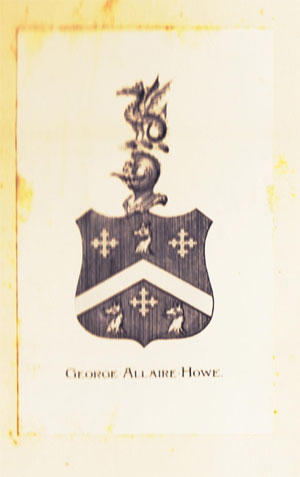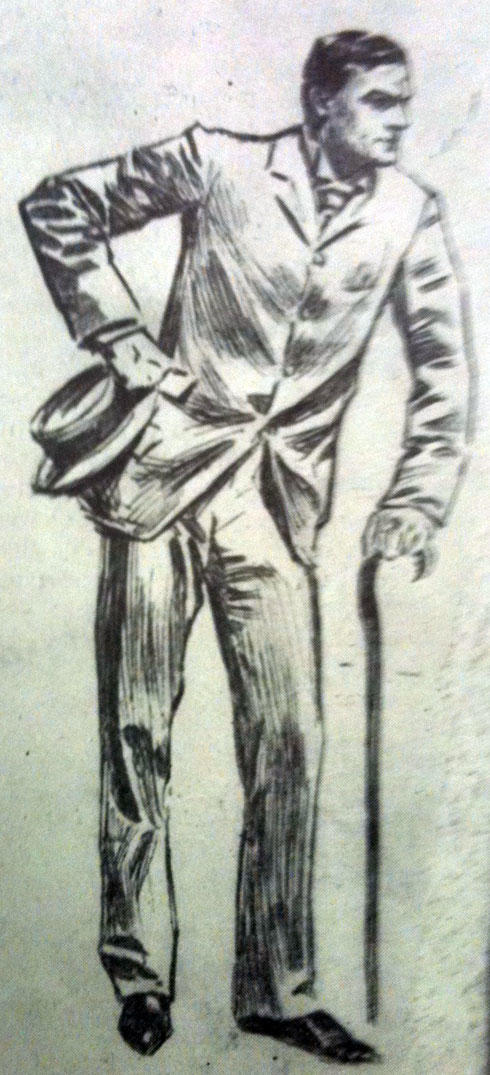“Life is a good deal like a book. What you get out of it does not depend so much upon what is written there as what you bring to it yourself.”
– Patrick Corse Heaphy, A Princetonian
Welcome to my conundrum. I am in receipt of a kind missive from my editora di tutti editori (recall, please, I was not a classics major) requesting I get with the program by aligning my thoughts here to the PAW Special Issue theme for this year, i.e. books.
You, the Discerning Historical Reader, will note that we currently are pretty far from any satisfying book, in the middle of a batch of microelectronic binary digits, the noble efforts of Jeff Bezos ’86 and his Kindle notwithstanding. So, in trying to fulfill my charge, it probably behooves me to start with an actual, physical tome and proceed thence.
So let’s talk about George Allaire Howe of the Great Class of 1878, for it is his book we’re looking at. Not one written by him, but one in his actual possession, bound in now-faded orange, with his stylish bookplate inside the front cover. It likely was purchased about 1896 when published by Putnam’s; that’s a year that rings familiar because Princeton had its combination Sesquicentennial/Renaming/Coming-Out Party then, complete with Professor Woodrow Wilson 1879’s “Princeton in the Nation’s Service” address. It was rah-rah time. Howe was the son of Pennsylvania Congressman Thomas Marshall Howe, the first president of the Pittsburgh Chamber of Commerce. Proudly “a steel man his whole life,” George Howe as an undergrad was a member of the brand-new Nassau Scientific Society, not Whig or Clio, in recognition of his technical interests. A highly loyal alum, he became president of the Princeton Club of western Pennsylvania and left Princeton $25,000 when he died just before the Crash of 1929. His book was written by James Barnes 1891, and is titled (wait for it …) A Princetonian: A Story of Undergraduate Life at the College of New Jersey. It found its way to a classmate of mine many years later; he generously gave it to me in honor of my highly documented weakness for anything orange with a tiger on the cover.
Now let’s talk about Col. Jim Barnes, the author and Squire of Stoneybrook (to quote PAW from May 15, 1935, in reference to his estate outside Princeton). Surprisingly little-remembered now, he was a combination Teddy Roosevelt, Ernest Hemingway, Richard Halliburton ’21, and Lowell Thomas *16, an “Author, War Correspondent, Explorer, Lecturer” according to The New York Times, who enlivened the literary world with articles (he cut his teeth at Scribner’s and Harper’s magazines after graduation), hundreds of short stories, and 28 books. A Princetonian was the first of the latter, part of a gung-ho college series Putnam’s was publishing and the only one that was a complete novel. Somewhat sickly growing up in New York City, Barnes had spent years on a Texas ranch before coming to Princeton as a 21-year-old freshman, winning the heavyweight Cane Spree bout against 1890, and so becoming 1891’s class president. He played freshman football (next to godhood in the 1890s of the Poe brothers; Edgar Allen Poe was a classmate), but then headed toward cultural activities, penning cartoons for the Bric, editing the Nassau Lit, serving as class orator on Washington’s Birthday, singing in the Glee Club, and resuscitating the Princeton Dramatic Association by writing its first musical, “Pocohontas,” in 1891. You now may know the group more familiarly as the Triangle Club.
So of course, only five years after having graduated himself, Jim Barnes in his novel tells a tale of Princetonian Newton Hart, a strapping working lad from the West (the book begins with a Princeton Glee Club concert in western Nebraska, of all places) who comes to Tigertown as “a young man with a purpose,” plays football, sings, is elected class president, and wins his cane-wrestling bout. He is on the verge of leaving because of his promise to marry the girl back home, but is reprieved when she elopes with a supposed rival. Thus spared to become successful, he learns from his wise friends, including the loyal but secretive (and secretly filthy-rich) classmate Patrick Heaphy, learns as well to identify false ones (including an obnoxious snob a couple years his senior), and falls in love with the virtuous, wise, unattainable Madge Hollingsworth, who is New York high society and clearly above him. Saved from potential ruinous scandal unintentionally set in motion by his kindness to his erstwhile prairie amour in distress, Hart sticks honorably to his path of hard work and savvy. In the end he’s rewarded after graduation with a lucrative company vice presidency by Heaphy, enabling Hart to sweep the gorgeous Madge into the (very prosperous Gilded Age) sunset. Finis; luck and pluck prevail in the best Horatio Alger tradition. Depending on your precise definitions, there are three or four dei ex machina and half-a-dozen spontaneous benevolent gifts upon which the plot stands – thus, a model of tight storytelling virtue it ain’t. But any Discerning Historical Reader will realize that its evocation of Cane Spree, bonfires, Step Sings, the Dinky, mixers, Witherspoon Hall (for the rich), Edwards Hall (for the not), and the solemn bell of Old Nassau easily allows it to rise to the realm of Great Literature.
Had Barnes written the same book 25 years later, it likely would have been quite different. Soon after its publication, he was off to cover the Boer War as a correspondent (as did Winston Churchill), and joined Kipling in publishing a paper for the British troops. He hung out with James McNeil Whistler and Henry James in London, traveled to Venezuela to obtain military information about the revolution on his first U.S. government assignment, cruised as a staffer on Joseph Pulitzer’s yacht for two years, and went on safari to Africa to photograph big game. After World War I broke out, he was one of the first Americans at the front, then returned home to tell war stories in preparedness lectures and organize the Princeton Aviation School, one of the first military flight training units in the country. He was commissioned, put in charge of American Army photographic intelligence, then sent back to France to run all Allied aerial photography after the United States joined the fight. He left active service as a lieutenant colonel, hence his title (you were wondering, right?). Afterward, he was the vice chairman of the 1919 University Capital Fund Campaign and, based at nearby Stoneybrook, was highly active in the affairs of his class, the Alumni Council, and Ivy Club for many years. He met every U.S. president from Cleveland to FDR. Having enough firsthand experience for many lifetimes, his writings covered naval and military history, more fiction, and dashing global adventure, in addition to his autobiography From Then Till Now, published two years before his death at 69.
But perhaps the sweetness of his younger writing (one of the chapters of A Princetonian is entitled “A Palaver”) is best for a fancy dedicated to “The Princeton Man: Past, Present, and Future”, i.e. to us. And such an atmospheric evocation certainly is felt best between two hard covers, with the immensely soothing tissue inserted between the frontispiece engraving of Nassau Hall and the title page. I suppose I could always read about Newt Hart on my Kindle or hear about him in a podcast, but in my book I actually can touch not only Hart, Heaphy, and the virtuous Madge, but Col. Barnes, George Howe, my generous classmate, and our many comrades, here and gone: a reading rainbow in many shades of orange, slightly faded with a tiger on the cover.















No responses yet